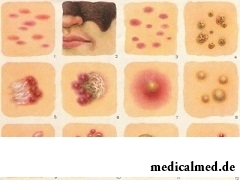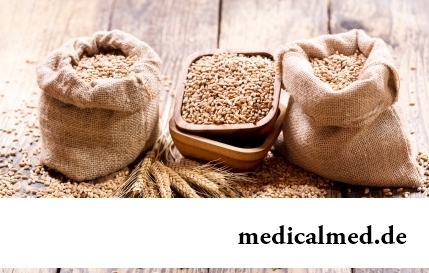





Skin rash
 Practically any dermatological disease is followed by emergence of skin rash. Skin is the biggest human organ and therefore disturbances of an internal homeostasis of an organism, than, in effect, are diseases, will lead to its change. Often these changes are shown by rash. Especially often skin rash occurs at children.
Practically any dermatological disease is followed by emergence of skin rash. Skin is the biggest human organ and therefore disturbances of an internal homeostasis of an organism, than, in effect, are diseases, will lead to its change. Often these changes are shown by rash. Especially often skin rash occurs at children.
Types of skin rash
Skin rash can be presented by different types. Rashes can be excellent from each other not only outward, but also emergence speed, an arrangement, existence or absence of an itch, etc.
There are following basic primary morphological elements of skin rash:
1. Spot or makula. It is located flush with not changed skin. Appears at disturbances of pigmental exchange, change of vessels, at introduction it is artificial under skin of dyes (a tattoo, etc.). The vascular spot usually has coloring options from dark cherry to light pink. When pressing disappears. Quickly recovers color. Such signs indicate inflammatory character. The spots which resulted from a vascular wall hyperpermeability are called hemorrhagic. The elementary example is bruise. The hemorrhage in skin in the form of points or spots of various form and size occurring owing to destruction of vessels of skin is called a hemorrhage (haemorrhagia). Petechias (petechia) are the smallest or dot hemorrhages. A set of hemorrhages of rounded shape of 2-5 mm in the diameter are described as a hemorrhagic purpura (a rigrig of hayetogghagioe).
Hemorrhages more than 5 mm of irregular shape are called ecchymomas (eshutoses).
Hemorrhagic rashes take place at a typhus, sepsis, hemorrhagic fevers. Star-shaped hemorrhagic skin rash is characteristic of a meningococcemia, sepsis. Also the nevus, telangiectasias, birthmarks, vitiligo (sites of a depigmentation) belong to vascular spots not of inflammatory character.
By the size allocate punctate skin rash in the form of a spot to the 5-10th and krupnopyatnisty with the 10-20th. Punctulate meets at a rubella, krupnopyatnisty can be a symptom of an allergy, measles.
At merge of large spots the erythema - erythema (Latin is formed). It appears at vasodilatation of a subpapillary vascular texture of skin. The size is more than 20 mm. A typical disease with an erythema – an erysipelatous inflammation. Burns of 1 degree are also a look erity. All not inflammatory spots resistant, when pressing do not disappear.
2. Blister or ultrica. Represents rather dense, towering over not changed skin, round or oval element of skin rash. Has no cavity. Itches. It is inclined to bystry emergence. Disappears completely. One of the most typical displays of skin rash in the form of a blister is the trace from a nettle. Often skin rash in the form of blisters meets at allergic reactions.
3. A papule, a small knot - papula. Represents bespolosny, the dense, towering over not changed skin element of skin rash. The size fluctuates from 2 mm to 3 cm. Large papules call plaques.
Depending on the size of a papule can be:
- miliary (about prosyany grain);
- lentikulyarny papules (about lentil, peas);
- numulyarny or monetovidny, formed at merge among themselves of flat large papules with a peripheral growth.
Very often at children it is difficult to distinguish skin rash in the form of papules from rozeolezny.
The papules arising in epidermis owing to a limited thickening of layers of cells are called epidermal flat warts. Also papules can be formed in a derma as a result of development of a tumor, an inflammation, adjournment of organic compounds (xanthomas, thermal papules at syphilis, etc.). Is also epithermal - the thermal papules arising at once from two layers of skin. Meet at red flat herpes, psoriasis, etc. The form of papules depends on a depth and can be flat, polygonal, sharp-pointed, semi-spherical.
Color of a papule depends on the reason of its emergence. So, inflammatory papules have red color. Gray-yellow color is characteristic of cholesteric papules.
This type of rash disappears completely.
4. The hillock or tuberkulum is the dense, bespolostny limited education located above the surface of not changed skin. Has the size of 1-10 mm. It is formed owing to accumulation in a derma of inflammatory infiltrate. It is distinguished from a papule by the fact that at a hillock palpation dense infiltrate accurately is defined. At involution the hillock is exposed to a necrosis, is frequent with an ulceration and education after itself a hem or a cicatricial atrophy of skin. Such type of skin rash meets as manifestation of a leushmaniosis, damage of skin at tuberculosis, and also tertiary and late inborn syphilis.
5. The node or nodus is limited, bespolostny, being deeply in skin consolidation. Towers over not changed skin. The size of nodes fluctuates from hazelnut to the egg size. This type of skin rash at accumulation of cellular infiltrate in a derma or hypodermic cellulose is formed. Nodes of inflammatory character of a pasty consistence or soft, have no clear boundary, are inclined to bystry disappearance and have more often reddish coloring of skin over them. The nodes formed more dense at a specific inflammation are inclined to an ulceration and disintegration. On their place the hem is often formed.
6. The bubble or vesicula is a strip type of skin rash the size the 1-5th. It is formed owing to epidermis amotio. It can be filled with bloody, muddy or transparent contents. Shrinks in a transparent or brown crust. At spontaneous opening the erosion with moknuty is formed. At accession of an infection the bubble turns into a pustule or a pustule (pustula). A characteristic type of skin rash at children in the form of a bubble are rashes at chicken pox. Also rashes at a herpes simplex, an enteroviral infection can be an example.
7. The bubble or bulla is the strip element located in an upper layer of epidermis and under it. Diameter is up to 3-5 cm. Contents can have serous, bloody or purulent character. It can be fallen down or be opened with formation of an erosion. Leaves behind unstable pigmentation. Meets at a herpetiform dermatosis (elements are located under epidermis) and a vulgar pemphigus (bubbles in epidermis).
Secondary types of skin rash are called the elements which are formed from primary, i.e. hyper - or a depigmentation, scales, erosion, grazes, ulcers, etc.
Treatment of Skin rash
 Regardless of that, rash display of a dermatological disease is or not, treatment of skin rash can be divided into 2 look:
Regardless of that, rash display of a dermatological disease is or not, treatment of skin rash can be divided into 2 look:
- Impact on the reason of emergence of skin rash, i.e. direct treatment of a basic disease. At emergence of any rash it is necessary to address the specialist who will be engaged in treatment of skin rash.
- Often skin rash is followed by an itch, elements can be opened, suppurate. For this reason, except treatment of the disease, respect for hygiene, processing of rash certain drugs, in some cases processing of skin preventively is necessary.
Stomatologists appeared relatively recently. In the 19th century to pull out painful teeth belonged to duties of the ordinary hairdresser.

Childbirth is the most important event in life of each woman. We are women we give birth to the new little man on this light. Now...
Section: Articles about health
The name of this disease precisely reflects the problem reason: it consists in the bra fastener pressure upon a certain zone of a back. At the same time one of vertebrae of chest department of a backbone is as if blocked and loses mobility, and falling on it is nude...
Section: Articles about health
According to doctors, more than a half of men of 25-50 years suffer from frustration of the urinogenital sphere, but the minority sees a doctor from them. And in vain - even the insignificant discomfort in the field of generative organs can serve as a symptom of an illness fraught with grave consequences for health. So - after 40 years - it is easy for most widespread disease of the sexual sphere of men to pass the first symptoms of prostatitis (weight in the bottom of a stomach, decrease in a libido), having written off for overfatigue and fatigue. Let's consider...
Section: Articles about health
Transfusion of donor blood has almost century history. In spite of the fact that this procedure is quite usual for many people, itself п...
Section: Articles about health
When overcomes feeling of hunger, and an opportunity to have dinner fully is absent, having a snack − the meals, small on volume, stabilizing sugar level in blood comes to the rescue. The relation of nutritionists to having a snack is more often negative, but only because in кач...
Section: Articles about health
The business lady, the become mother, it is necessary to solve an array of problems. But of them is main: how to combine the beloved child and work? What traps trap the working mother and how she needs to behave?...
Section: Slideshow
The next flu epidemic leads to the next panic, from year to year we give in on these manipulations: professionally alarming goal...
Section: Articles about health
To look healthy and means well-groomed not only to be pleasant to people around, but also to feel strong, sure and taken place. Specialists in the field of cosmetology quite often note that whether not all women are able to look after skin...
Section: Articles about health
The kid who was recently born is surrounded with love of adult family members and their cares without which the baby cannot exist. Some parents consider that gentle attachment and caress are quite enough that the child correctly developed and was happy, but it not so. It is important to know as much as possible about specifics of care of the baby, the reasons of his behavior and possible problems. Only the "able to see" love will provide to the little man that it is necessary for him....
Section: Articles about health
Tea is loved and use almost everything. This drink has tonic properties, contains the tannins capable podavlit...
Section: Articles about health
You are office worker, the driver, the fan of winter sports or do not think of life without bicycle? You lead a slow-moving life and you move on the city only on the car? You have no constant partner and you do not love the protected sex? Attention! You one...
Section: Articles about health
The healthy nutrition is the invariable principle of health and good health for long years of the woman. Nevertheless, in a diet at each stage of life there are the features allowing to support an organism by those substances which are most necessary for it at present. Eating according to them, the woman will be able to feel vigorous and strong, and also to adapt to changes in an organism so that they allowed it to lead active lifestyle at any age....
Section: Articles about health
It is known that the person for 80% consists of water which participates in all processes of an organism. The person loses liquid daily – in...
Section: Articles about health
Life of the modern woman is very difficult. Opportunities to realize itself are wide: it not only education and career, but also the most various hobbies from sport before needlework. It is not less important to build private life, paying an attention maximum to children, the husband, parents, e...
Section: Articles about health
Statistically, pathologies of a thyroid gland in the world more than 500 million people have. Failures in work of this body lead to heavy disbolism, development of heart diseases, vessels, a reproductive and nervous system. In hard cases excess or insufficient production of the main hormones of a thyroid gland (thyroxine and triiodothyronine) leads to essential decline in quality of life and disability....
Section: Articles about health
Olive oil – the product capable to make a powerful contribution to health of the person if it includes it in the diet. Rich vitamin...
Section: Articles about health
For many women the word "fat" sounds as a sentence. In aspiration to an ideal figure they try to exclude, first of all, from the menu all dishes containing fats without having at the same time a clear idea of a role of these substances in exchange processes, and about an afterbirth...
Section: Articles about health
All the known slogan "Protect Men!" arose not from scratch. In a sense, the nature created men much less adapted for vital disorders, than it seems at first sight. Statistically, men are ill more often, than women, have the majority of illnesses heavier and earlier die. The situation is aggravated with the fact that our fathers, husbands, brothers and sons are not always inclined to care for the health. Partly it happens because of unwillingness of t...
Section: Articles about health
Life of the modern child is extremely active and difficult. Information strain which is experienced by the school student and did not dream the pupil...
Section: Articles about health
Sugar - the digestible refined product which is not of special value for an organism of the modern person. The use of sugar in food is based rather on the psychological dependence caused by desire to indulge itself with something tasty, and in дальнейш...
Section: Articles about health
Physical activity is necessary for normal functioning of a human body. At a lack of the movement joints cease to function, muscles atrophy, cardiovascular activity is broken and the metabolism worsens. The modern city rhythm of life does not provide the person with an adequate exercise stress, additional - sport is necessary. Tedious tasks the huge number of the people having those or ин exists sport not all to liking, but also...
Section: Articles about health
Season of activity of viral infections in the heat. Everyone can get sick, but probability of this unpleasant event it is possible and it is necessary miny...
Section: Articles about health
The nature does not stand stagnation and monotony. It is known that tissues of a human body atrophy if do not receive necessary loadings. It fully belongs also to a cerebral cortex: when it is not given full-time job, it begins to function worse. In резуль...
Section: Articles about health
Extracorporal fertilization – one of the most modern methods of controlling with infertility. So far he already helped a significant amount of married couples to become happy parents. Usually to the EKO procedure difficult and very expensive, resort in those situations when all other ways to help couple to bring the child are inefficient. "Conception in a test tube" yields quite good results in cases of infertility of one of partners, existence at the woman of impassability of uterine tubes...
Section: Articles about health
The concept "gluten" (differently, a gluten) combines group of the proteins which are a part of rye, barley and wheat. For most of people упот...
Section: Articles about health
What is in our understanding weeds? It plants which are considered to be suitable only for compost pits and feeding of animals. Meanwhile, among the weeds growing literally under legs it is possible to find the mass of the officinal herbs possessing invaluable Paul...
Section: Articles about health
All of us, unfortunately, should face flu nearly an every year. It would seem, so frequent disease has to be studied already up and down, and each person, at least once to them had (and the number of such people in our country aims at 100%), has to know the basic rules of its treatment. However as shows experience of doctors, there is no it, and often people, self-confidently thinking what is known as it is necessary to be treated, make mistakes....
Section: Articles about health
